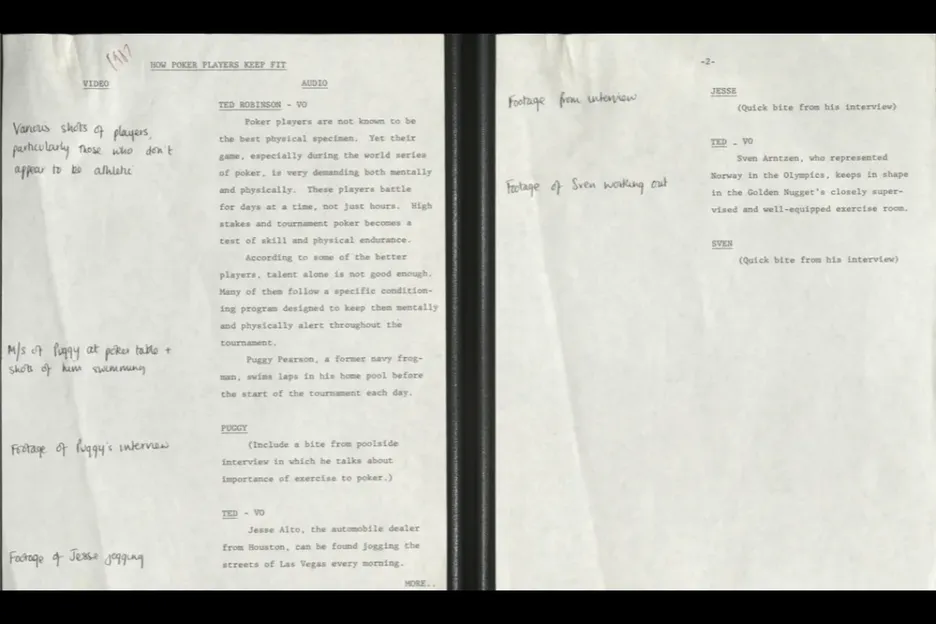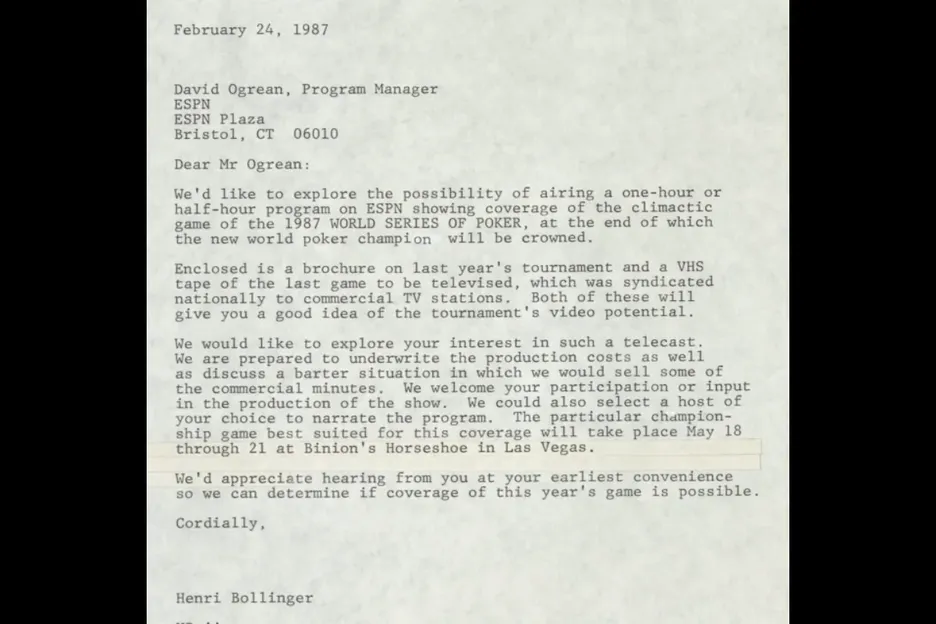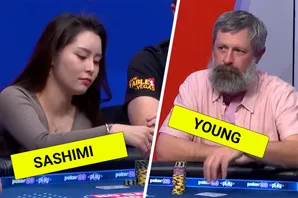In 1987, after several patchwork years of documentary shows on the CBS Sports Spectacular and syndicated television, Henri Bollinger contacted ESPN about airing a one-hour WSOP Main Event special on the up-and-coming cable sports network.
“We’d like to explore the possibility of airing a one-hour or half-hour program on ESPN showing coverage of the climactic game of the 1987 World Series of Poker,” Bollinger wrote to David Ogrean, Program Manager at ESPN on February 24 of that year.
Bollinger, a high-powered Los Angeles press agent acting on behalf of Binion’s Horseshoe Hotel & Casino, offered to underwrite the production costs, as well as a “barter situation” in which Binion’s would sell some of the commercials on the program.
The original agreement
ESPN was in the midst of early growing pains, having been purchased by ABC (Capital Communications) in 1984. The network began striking new deals for live sports like the National Football League and cable television was opening up to more homes each year (ESPN was available in nearly 50 million households in 1987).
The WSOP documentary represented an opportunity to fill out the cable network's lineup with cheap, original programming. Early ESPN partners of the 1980s included the Little League World Series, the United States Football League, and motorsports coverage. Shows like SportsCenter and SpeedWeek would complete the rest of the schedule with repeated airings. The NFL's Sunday Night Football started in 1987, putting the network on a path to being the self-named Worldwide Leader in Sports.
The 1987 WSOP was scheduled to take place May 18–21. Bollinger would produce the documentary under his B-movie film label Translor Films in partnership with Trans World International — a production banner of International Management Group (IMG) — a company that would go on to produce much of what we see today in live sports.
A letter from TWI’s Barry Frank to Jack Binion and Bob Yamin of Translor Films laid out an agreement where Binion’s Horseshoe would stage the tournament, Translor Films would produce the show, and TWI would be responsible for all arrangements with ESPN. The agreement also called for payment of $100,000 from Binion’s Horseshoe to “help defray production expenses.”
Camera falls on foot, lawsuit ensues
The production took place during the final days of the Main Event in May, and Johnny Chan's first WSOP Main Event title went off without much trouble, save for a fallen camera on May 19 that resulted in a lawsuit. An incident report from the casino states that the victim, a Las Vegas local, was standing near a chair on which a TV camera was leaning. “When a customer passed by accidently (sic) knocking the camera over and causing it to land on the victim’s foot.”
A lawsuit followed and ESPN, having nothing to do with the production, was annoyed to receive repeated contact about the incident. Translor Films and Binion’s Horseshoe appear to have negotiated a settlement with the victim later that year.
Post-production begins
Post-production of the documentary began immediately, and a fax on June 10 to ESPN from Gordon Smith, a Vice President at TWI, spelled out an early story treatment.
“It appears we should have a fairly refined version available around July 20th,” the fax said. This would prove to be overly optimistic.
The early treatment is hosted by Ted Robinson, who opens the show by chatting with the six finalists. It mentions Doyle 'Texas Dolly' Brunson as one of the early casualties, as well as Amarillo Slim Preston. A 23-year-old Howard Lederer gets a nod as the youngest person to land in the money since the tournament began 18 years before. See the gallery below for the full four-page treatment.
How Poker Players Keep Fit
Later that month, on June 29, Bollinger sent a letter to Translor Films partner Bob Yamin with scripts for packages and segments to be used in the show. Bollinger’s notes are an early look into the TV challenge of making poker exciting:
“Remind Marty to try to find hands that were narrated by Ted (Robinson) and his co-hosts from home base, rather than have Ted do solo VO (voiceover) narration for each hand. The duo narration will make the show considerably more interesting.”
An included script calls for a segment titled How Poker Players Keep Fit, with Robinson providing voiceover on top of video clips of “various shots of players, particularly those who don’t appear to be athletic.” Cut to Puggy Pearson, who is shown swimming and interviewed poolside, while Jesse Alto is jogging the streets of Las Vegas. They even show Norwegian Olympian Sven Arntzen getting a session in at the Golden Nugget weight room.
The long summer
On July 2, Bollinger sent a full synopsis of the telecast to TWI with a note that there would still be some changes to the final show.
A gap in correspondence indicates a slowdown in production or an airdate later in the winter that slowed a sense of urgency. It wasn’t until September that plans emerged to promote the documentary.
“We’ll need a six-week lead period prior to air date to maximize the impact of the campaign,” Bollinger told TWI. “There are an estimated 50 million Americans who play poker on a regular basis. To them, the World Series of Poker is the game’s premier annual event.”
The campaign called for press kits to be sent all over the country, including the story of the tournament, feature stories, color slides, photos, and a 44-page brochure. The press kit was also sent to promotion managers of cable systems that carried ESPN and newspapers in the markets where ESPN was shown.
The rest is history
A few months later, on December 14, Gordon Smith at TWI wrote to ESPN as production wrapped up.
“Attached please find the revised and corrected World Series of Poker program. I think you will agree it is a significantly improved program. Please let me know the airdates as soon as possible.”
The letter continues, “On another front, I have a baseball program idea I would like to discuss with you soon.”
TWI and IMG would grow to be a central production partner of Major League Baseball, and ESPN signed their first deal with the league in 1990.
The documentary aired on ESPN a short time after, but it’s difficult to pin down the exact date. Cable was a new world at the time, and schedules were less predictable. The special could have aired on a specific date, or it could have been used to plug a gap in programming made by a live game running long or ending too early. It likely aired several times throughout 1988.
The following year’s 19th WSOP brought the famous conclusion between Johnny Chan and Erik Seidel for Chan’s second straight Main Event win. The partnership with ESPN continued through 1998 before the annual documentary spent a few years on Discovery Channel.
ESPN coverage returned in 2002 before it expanded in 2003 and 2004, thanks to the buzz around 2003 champion Chris Moneymaker and a National Hockey League labor lockout that forced the network to fill anticipated gaps in the schedule with a high volume of cheap programming. The expanded coverage would combine with the proliferation of online poker to create what we now know as the Poker Boom.
More in the 1987 WSOP gallery:
Letters and correspondence obtained from Binion's Horseshoe Casino Records on Poker, 1960-2006. MS-00325. Special Collections and Archives, University Libraries, University of Nevada, Las Vegas. Las Vegas, Nevada.






































